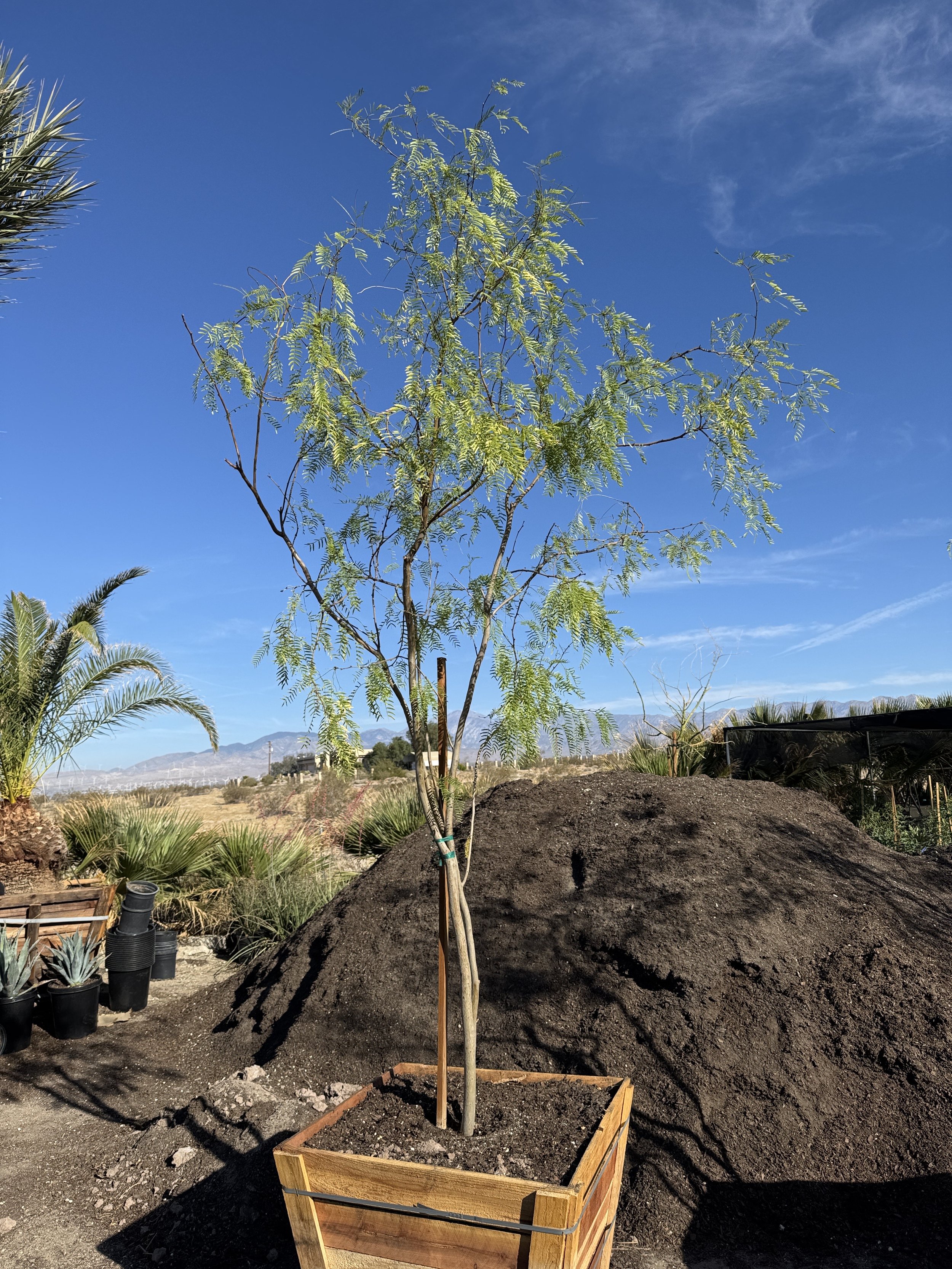Mesquite Tree
The mesquite tree has a graceful and informal appearance, reminiscent of open pastures and fields.
It is quite popular here in the Coachella Valley because it is one of the most heat and drought resistant trees that can survive our harsh summers with minimal maintenance.
*The most common varieties that we sell are the Chilean mesquite tree and honey mesquite tree.
Botanical name (of genus): Prosopis, Neltuma, Strombocarpa
Chilean mesquite trees for sale at the nursery
TABLE OF CONTENTS
Mesquite Tree Appearance
There are over 40 types of mesquite trees. In general, the mesquite tree is a medium-sized tree or a large shrub that can reach 40 feet in height. It has a graceful and informal appearance with open growth of twisted branches and droopy leaves.
Gray or light brown trunk will become darker and rougher as the tree matures.
Many mesquites have sharp thorns.
Tiny, narrow green leaves grow in pairs to form leaflets.
Small, yellow flowers bloom during warm weather, typically spring to fall in the Palm Springs region.
Followed by dark colored seed pods.
Mesquite Tree Landscaping Tips
Creates dappled shade with its canopy. Great for providing shade in the garden.
Very drought and heat tolerant once mature. Use to create a resting area and/or to protect smaller plants from heat. Can be planted in hot areas with poor soil.
Flowers attract pollinators such as bees, butterflies, and birds.
Produces seedpods, which are eaten by some livestock. Seeds contain high protein. Native Americans used the seeds and seedpods for preparing food and beverages.
Extensive root systems that help them absorb water in arid areas. Allow plenty of room for tree and roots to grow.
Famously used for adding a unique smoked aroma for grilling.
Mesquite Tree Origin
Mesquite trees are from warm and dry areas in the Americas
Mesquite Tree Care
Soil: Tolerant of a variety of soils, including loose and compact desert soils.
Temperature: Many mesquite trees can withstand temperatures down to 25 degrees for a short period of time.
Water: Drought tolerant once mature. Occasional, deep watering. For new and young trees, water more often.
Sun: Full sun. Partial shade in the Palm Springs area is ok.
Mesquite Tree Problems
Pests: When healthy, mesquite trees have minimal pests, but the most common are spider mites. Control the infestation as soon as it’s discovered. Some options are horticultural oil applied several days apart as well as insecticidal soap combined with hydrogen peroxide.
Signs of overwatering: Weak branch growth, leaf drop, leaf discoloration
Signs of too little water: Leaf drop, leaf discoloration, wilted leaves
Signs of too much sun: Burning, scarring, fading color
Signs of too little sun: Etiolation, discoloring
Honey mesquite tree for sale at the nursery
Mesquite Tree Propagation
Obtain mature seeds pods and open them to get the seeds. Plant in well-draining soil and keep moist until it sprouts.
FAQ
How much does a mesquite tree cost?
At our nursery, a honey mesquite tree and Chilean mesquite tree cost $35 for a 5-gallon container, $120 for a 15-gallon container, $250 for a 24-inch box, $500 for a 30-inch box, $750 for a 36-inch box, and $2,500 for a 48-inch box.
Prices are subject to change. Please contact us for the most up-to-date information on pricing. We may have larger sizes available. We provide installation services locally at a separate cost.
Are mesquite trees evergreen?
Mesquite trees are evergreen in warm places with mild winters where it gets regular irrigation. In colder regions, they are deciduous.
How fast do mesquite trees grow?
Many mesquite trees grow moderately fast at about a 1-2 feet per year.
Summary
| SIZE (H X W) | 40 feet x 40 feet |
|---|---|
| FLOWER COLOR | Cream / Yellow |
| FLOWER SEASON | Spring to Fall |
| EXPOSURE | Full Sun |
| WATER | Low |
| GROWTH RATE | Moderate |
| HARDINESS | 25º F, USDA Zone 8 |
| PRUNING | As needed |


